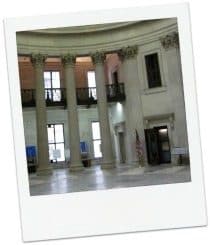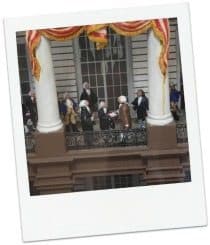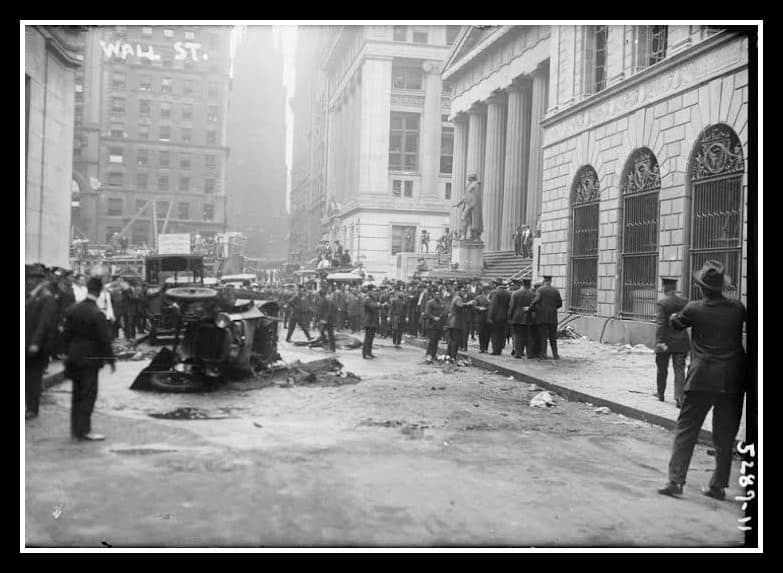The corner of Wall Street and Nassau street has been the site of government activity and played a prominent place in American history for more than 300 years.
So many significant events of early America occurred at the buildings that have stood at this location including the first stirrings of pre-Revolution discontent and the post-Revolution formation of our federal government.
This was the site of George Washington’s inauguration and the place where the Bill of Rights was officially passed.
Though the original building that served as the nation’s first capital is gone, the current grandiose Federal Hall building serves as a national memorial to the events that occurred here.
- Location: 26 Wall Street (between Broad and William Sts). Handicapped accessible entrance at 15 Pine Street.
- Directions: Subway: 2, 3, 4, 5 to Wall Street, J or Z trains to the Broad Street station, 1 or R trains to Rector Street, A or C trains to Fulton Street.
- Hours: The building is open Monday through Friday from 9:00 a.m. to 5:00 p.m. Closed on weekends and for all Federal holidays.
- Admission: Free
- Self-Guided Tours: Self-guided tours are available Monday through Friday from 9:00 a.m. to 5:00 p.m.
- Guided Tours and Talks: Free guided tours are run Mon-Fri at 10 a.m, 1 p.m, 2 pm and 3 pm. The schedule is subject to staff availability.
Group reservations: Groups of 10 to 30 persons can make reservations for private programs.
INSIDE THE FEDERAL HALL NATIONAL MEMORIAL
Rotunda
In this domed main exhibition room, which feels like a micro-capitol building, you can see the actual Bible that Washington took his oath on at his inauguration.
The Inaugural Bible is ‘permanently’ on loan from St. John's Masonic Lodge Number One.
On Inauguration Day, everything was ready for Washington to be sworn in when it was discovered that no Bible had been brought for the occasion!
The Marshal of the Inaugural parade happened to also be the Master of St. John's Lodge.
He ran down the street to the Lodge at the nearby corner of Water and Wall Streets, grabbed the Lodge’s Bible and brought it back for the swearing-in.
The Inaugural Bible has been on loan ever since.
On the east end of the Rotunda you can see a large cracked marble slab from the balcony floor of the original Federal Hall where Washington was inaugurated.
You can also see part of the building’s wrought iron railing that was salvaged in 1812.
There are also a handful of dioramas illustrating Washington’s inauguration, as well as many original documents, paintings, and artifacts from early America, including New York’s ratification of the Bill of Rights.
There are also temporary exhibits, like the one on display until April 15, 2016, celebrating the diverse cultural, social, and political history of the New York City neighborhood of Harlem.
Be sure to check out the heavy vault doors in the four corners of the room.
They are a reminder of when the building was one of America’s six sub-treasuries storing vast amounts of gold and silver bullion in its basement.
New York Harbor Visitor Information Center
As Federal Hall National Memorial falls under the purview of the National Parks Service, the visitor center has information about opportunities provided by the many destinations of the National Parks of New York Harbor.
Also in the Center are a few items that belonged to the very first First Lady, Martha Washington, such as the ring she wore while in mourning after the death of her husband.
Portrait Gallery
Here you can see paintings of George Washington and Alexander Hamilton as well as a display showing the restoration of Hamilton Grange National Memorial on its new site in St. Nicholas Park in Harlem.
John Peter Zenger Display
Across the visitor center is a small display regarding the trial the of John Peter Zenger.
The display contains an old printing press and information about how the trial led to the American conception of freedom of the press, now protected in the First Amendment to the Constitution.
HISTORY
The first building on the site was erected by the British to serve as City Hall of the colony of New York. Civic affairs were tended to here as well as legal matters.
It was here that in 1735, New York colonist and newspaper publisher John Peter Zenger dared to criticize the British royal governor of New York.
Zenger was arrested for committing libel and was imprisoned. He was put on trial and found not guilty having presented a vigorous defense that the material he had printed was true.
His trial and the outcome laid the foundation for what would become one of America’s most sacred values, freedom of the press, later defined in the Bill of Rights.
In 1765 the Stamp Act Congress (consisting of representatives of nine colonies) met on the site to protest British Parliament's Stamp Act, one of the many tax acts that weighed heavily on colonists and which fueled resistance to taxation without representation throughout the colonies.
The growing frustrations of the colonists ignited into revolution on July 4, 1776, and the Revolutionary War was finally won by the colonists in 1783 and America was born.
From 1785 to 1789, the old City Hall building was used by the new American Congress who, in 1788, ratified the Constitution.
New York City served as the nation's temporary capital while discussions went on about where the permanent home for the federal government should be.
Hoping to convince the new Congress to make their city the permanent seat of government, local business interests contributed funding for a major expansion of the City Hall.
In 1789, the old City Hall building was gutted and remodeled according to a design by Charles Pierre L'Enfant, (who later designed the city of Washington D.C.)
When the building was done, it was the first example of what we now refer to as Federal-style architecture.
It was from the balcony of the impressive new building, aptly named Federal Hall, that one of the most profound moments in American history occurred on April 30, 1789: George Washington was sworn in as the first President of the United States.
Later that year at Federal Hall, Congress adopted the Bill of Rights and also the Judiciary Act which established the court system still in use today.
Today's Supreme Court and the Departments of State, Defense and the Treasury can trace their beginnings to Federal Hall.
After only a year Congress moved temporarily to Philadelphia and then to the newly built capital city of Washington, D.C.
With the Congress gone and Federal Hall, although modeled, was still built on the much older City Hall structure, the city decided to tear down Federal Hall and replace it with a new structure.
Despite its massive historic significance, the building was razed and its pieces sold for scrap, fetching $425.
The impressive building that now stands on the site was erected in 1842 to serve as the Customs House for the Port of New York.
Designed by Ithiel Town and Alexander Jackson Davis, the neo-classical style building embodies America’s most sacred ideal.
The Doric columns of the façade resemble those of the Parthenon in Greece, the birthplace of democracy.
The domed ceiling inside, designed by John Frazee, also echoes the Pantheon.
In 1882, John Q.A. Ward's bronze statue of George Washington was erected on its front steps, marking the approximate site where he was inaugurated as president in the former structure.
His arm is outstretched with his hand placed on what would have been a bible.
Though the statue does not include the bible, the actual bible that Washington took his oath upon is inside the Memorial on display for you to see up close.
In 1862, New York Customs operations had outgrown the size of the building, they moved to a larger location. (While you are in the neighborhood, be sure to walk over to the magnificent former U.S. Customs House at Bowling Green, an architectural masterpiece).
In 1882, one of the United States Sub-Treasuries located here. Millions of dollars of gold and silver were kept in the basement vaults until the Federal Reserve Bank a few blocks away was built to house the nation’s wealth.
In 1939, the Secretary of the Interior declared the structure a National Historic Shrine and in 1955 Congress renamed it Federal Hall National Memorial in honor of the building’s original purpose.
IN MODERN TIMES
In 1920, a bomb was detonated across the street from Federal Hall, right in front of the headquarters of J.P. Morgan & Co., the nation's most powerful bank.
The event, now referred to as the Wall Street bombing, thirty-eight people were killed and 400 injured and the Morgan building was visibly damaged, but Federal Hall received no damage.
One survivor noted of the nearby statue of George Washington: “Looking down from its pedestal between the massive granite columns, scarred by missiles from the explosion, the outstretched hands of the Father of His Country seemed to carry a silent command to be calm...”
On September 11, 2001, Federal Hall served as a makeshift refuge for 250 people running from the massive dust cloud formed by the collapse of the Twin Towers located just four blocks away.
The building had to be closed for a month to clean the interior of hazardous dust and to assess structural damage.
On September 6, 2002, one year after the World Trade Center attacks, approximately 300 members of the United States Congress convened in Federal Hall to show support for the city on the first anniversary of the attacks.
The last time Congress met in New York City was at that site over 212 years earlier.
On January 31, 2007, President George W. Bush delivered his State of the Economy speech in front of a special session of Congress.
And two years later, on September 14, 2009, President Barrack Obama spoke before an audience of Wall Street's elite regarding regulatory reform and the need to restore America's faith in the financial sector.
WHAT TO SEE IN THE NEIGHBORHOOD
Your visit to Federal Hall will not take up too much of your time and there is so much more in this New York neighborhood of Lower Manhattan to do. Here are some suggestions:
- Tour the neighborhood on your own with our Lower Manhattan self-guided tour or our
- Wall Street self-guided tour (Check out our full selection of self-guided NYC tours of the many wonderful neighborhoods of NYC)
- Join one of our pay-what-you-wish guided tours of Lower Manhattan or one of our other walking tours that visit lots of different neighborhoods New York
- Take the Staten Island Ferry a free boat ride with outstanding views of the New York Harbor.
- Visit the nearby 9/11 Memorial










